- Travel + Photos
- Voyages
- Kingdom of Bhutan
Kingdom of Bhutan: another world

It all started with a picture of the Taktsang monastery. For some reasons, I wanted to visit the place and see it for myself. A year later almost to the day, here I am inside that same monastery.
One single airline carrier operates in Bhutan: the national carrier Royal Bhutan Airlines or Druk Air. Druk means dragon in Dzongkha, the official language of Bhutan. The approach to the town of Paro is like a flight on the back of the dragon. The airplane glides so close over the mountains that its wings almost touch the side of the mountains. Gracefully, it slips through the peaks, veers to the right and finally lands at the Paro International Airport, the only one of the country.
As soon as you get out off the airplane, you know you are not in a country like any others. The buildings of the airport look more like a temple. The debarkation is then instantaneously transformed into a photos shooting session.
The Country
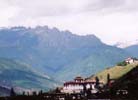 The Kingdom of Bhutan is a small landlocked country a little larger than Switzerland, located between Tibet in the north and India in the south. Also called Druk Yul - Land of the Thunder Dragon - Bhutan is one of the most ruggedly mountainous countries in the world, rising from 200 m (656 feet) at a narrow semitropical strip on the southern border to over 7500 m (24,600 feet) in the Himalayas in the north. The geography of Bhutan is marked by north-south oriented mountain chains that divide the valleys. The passes between each valley are high (up to 4000 m, 13,120 feet), which isolates the regions and creates local particularities.
The Kingdom of Bhutan is a small landlocked country a little larger than Switzerland, located between Tibet in the north and India in the south. Also called Druk Yul - Land of the Thunder Dragon - Bhutan is one of the most ruggedly mountainous countries in the world, rising from 200 m (656 feet) at a narrow semitropical strip on the southern border to over 7500 m (24,600 feet) in the Himalayas in the north. The geography of Bhutan is marked by north-south oriented mountain chains that divide the valleys. The passes between each valley are high (up to 4000 m, 13,120 feet), which isolates the regions and creates local particularities.
On this trip, I visited the west and central regions: Paro, Thimpu, Punakha, Wangdue Phodrang, Trongsa and Bumthang, whose altitudes vary between 1300 m (4260 feet) and 2700 m (8860 feet). Among them, only the valleys of Paro and Bumthang are flat. The cities are usually on the border of a river in the valleys, where rice and wheat are cultivated as well. The mountain slopes are covered with forests. Even at altitudes of 4000 m, the landscape is still forested, which is strange for me who am used to seeing timberlines around 2200 m (7200 feet) on the mountains.
There is an abundance of rivers in Bhutan and they are a great source of hydroelectric power for the country. They are pristine and the water is a clear, greenish-blue colour. I scouted several rivers that seem to be great class 3-4 for kayaking. However their access is a problem as the rivers are often buried in several dozen metres high gorges (hundreds of feet). Consistent with the environmentally friendly policy of the government, just a few dams have been constructed. But since domestic requirements for power are modest, the majority of the energy produced is exported to India.
Driving is on the left side in Bhutan, but sometimes it can be hard to tell as people drive in the middle of the roads since they are narrow. With narrow, windy roads that are not always in good shape, driving in Bhutan is slow and I would call it "cooperative". People slow down and pull to the side to let faster cars pass by. Where the road is too narrow for cars from both directions to cross, they would stop somewhere broad enough (sometime after backing up) and patiently wait for the cars going the other direction to cross before driving on. There seems to be no road rage or flaring tempers. On the contrary, Bhutanese drivers are quite courteous. They honk once to let the slower driver know they want to pass, twice or more to indicate they will be passing. Once passed, they honk once to say "thank you", which is responded by one honk for "you're welcome". There are no traffic jams, except when the cows are slow to get off the road.
Beside the capital Thimpu, cities are small and are usually organized around a road (the one passing by the town) or an intersection of two roads. There is no traffic light in Bhutan; nowhere. For some busy intersections in Thimpu, there is a policeman directing traffic. The dogs are everywhere in the towns. They do not belong to anyone and roam freely in the streets. They are not aggressive and do not bark, except at night, when one starts to bark then the others follow in concert.
School is free in Bhutan. The educational system consists of one year pre-primary, classes from 1 to 12, and a 5-year college. There is one single college in Bhutan, thus its entrance is very competitive. Those who cannot enter there usually go to India for their higher education. The lessons at school are taught in English, and Dzongkha is taught as a second language. Despite the fact that a good number of Bhutanese are fluent in English, the majority of them are not (but speak some) and many do not speak any English, specially the monks, the elders and those living in rural areas.
People
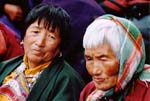 Bhutanese are very friendly and kind, but above all they are honest, polite and respectful. Like in most Asian countries, people are addressed differently according to their age and their rank. Additionally, Bhutanese greet people differently according to their rank. Men of the same rank shake hands with two hands to show mutual respect. A respectful greeting (to someone of a higher rank) is done by bowing with two arms straight down and palms open forwards. One time when exiting a monastery in Kuengarabten, I crossed three young girls who were studying for their Dzongkha exam on the grass outside of their school. When they saw me, they stood up and presented their respectful greeting to me, to my great surprise.
Bhutanese are very friendly and kind, but above all they are honest, polite and respectful. Like in most Asian countries, people are addressed differently according to their age and their rank. Additionally, Bhutanese greet people differently according to their rank. Men of the same rank shake hands with two hands to show mutual respect. A respectful greeting (to someone of a higher rank) is done by bowing with two arms straight down and palms open forwards. One time when exiting a monastery in Kuengarabten, I crossed three young girls who were studying for their Dzongkha exam on the grass outside of their school. When they saw me, they stood up and presented their respectful greeting to me, to my great surprise.
Bhutanese still wear their traditional dress. Men wear the gho; women wear the kira, often with a toego (a kind of vest) over it. At governmental places such as the dzongs or during formal occasions, bhutanese men also wear the kabney, which is a kind of scarf. The colour of the kabney indicates the rank of the person wearing it; white for ordinary citizens, yellow for the king, etc.
Tantric Buddhism is the official national religion, and Bhutanese are very religious. Conformed to their religion, they don't slaughter nor kill living beings, whatever they are. Therefore, bhutanese food is essentially vegetarian base: rice, potatoes, vegetables and a lot of chillies. It is not, however, exclusively vegetarian. The meat comes from dead animals (by accident or natural causes) or from India. It is therefore dry and does not have much flavour. That being said, I find their beef noodle - which is not a soup - to be very much to my taste. On the other hand, I cannot get used to the butter tea, which tastes like tea with salted butter, really. I was told that it is taken in the morning or with a meal.
Bhutan not being a developed country, most of the people live from agriculture and they are self-sufficient. They raise cows and goats for the milk, and cultivate rice, wheat and vegetables for food. People in the villages help each other, and even the monks give a hand for the harvest. They sell the excess in town or trade it for other goods.
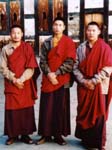 Having almost no machinery, Bhutanese work hard. They labour the land thanks to their cows and beat the rice and wheat by hand using a two-piece wood stick articulating in the middle. I had the opportunity to try it during my visit to the Shabji Tang temple in Bumthang. It is not that easy to do it correctly and is hard work in the long run. The wooden frames of the houses are painted by hand. A hammer is used to break big rocks into gravels. Weaving of the fabrics is done by hand, and therefore they are of very high quality. In some regions, they put bamboos on the road so that the cars would flatten them, which are then used to make roofs or barns. And of course, the best mean of transportation in rural area is still walking; the distances between villages in those areas are still measured in hours or days.
Having almost no machinery, Bhutanese work hard. They labour the land thanks to their cows and beat the rice and wheat by hand using a two-piece wood stick articulating in the middle. I had the opportunity to try it during my visit to the Shabji Tang temple in Bumthang. It is not that easy to do it correctly and is hard work in the long run. The wooden frames of the houses are painted by hand. A hammer is used to break big rocks into gravels. Weaving of the fabrics is done by hand, and therefore they are of very high quality. In some regions, they put bamboos on the road so that the cars would flatten them, which are then used to make roofs or barns. And of course, the best mean of transportation in rural area is still walking; the distances between villages in those areas are still measured in hours or days.
Tourism is probably a very important source of income in Bhutan. However there is no beggar harassing the tourists or people who try to take advantage of them like in certain other countries. In fact, I did not see any beggars at all.
Not being rich and needing to work hard, Bhutanese seem to be happy anyhow. In fact, his Majesty King Jigme Singye Wangchuck speaks of Gross National Happiness (GNH) as measurement of the nation's wealth instead of the gross national product. The GNH is part of the official government policy where cultural, environmental, spiritual well being and happiness of the people comes ahead of monetary wealth.
Leisure
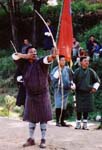 The most popular sport in Bhutan by far is archery. Archery is a team sport and the tournaments are done by direct elimination. The archery field is about 120 m (360 feet) long with a target at each end. The target is a rectangular piece of wood 50 cm by 5 cm (20 x 6 inch) by my estimation. A match opposes two teams, half of each team being at each end of the field. The two teams take turn to shoot, one member at a time. Team members of the shooter, the ones at the other end of the field, stand next to the target and shout encouragement. They do not go away from the target when their team member shoots. When the arrow comes, they just bend their body or make a quick step aside to avoid it! I am not sure how they do it because I had a hard time seeing the arrow and following its trajectory. If the arrow hits the target, the entire team celebrates with a dance and chant at both ends of the field. Each person can try three shots. Once all players from one end have finished shooting, the players at the other end take place to shoot. One point is granted for each target hit; the first team to reach a certain number of points wins.
The most popular sport in Bhutan by far is archery. Archery is a team sport and the tournaments are done by direct elimination. The archery field is about 120 m (360 feet) long with a target at each end. The target is a rectangular piece of wood 50 cm by 5 cm (20 x 6 inch) by my estimation. A match opposes two teams, half of each team being at each end of the field. The two teams take turn to shoot, one member at a time. Team members of the shooter, the ones at the other end of the field, stand next to the target and shout encouragement. They do not go away from the target when their team member shoots. When the arrow comes, they just bend their body or make a quick step aside to avoid it! I am not sure how they do it because I had a hard time seeing the arrow and following its trajectory. If the arrow hits the target, the entire team celebrates with a dance and chant at both ends of the field. Each person can try three shots. Once all players from one end have finished shooting, the players at the other end take place to shoot. One point is granted for each target hit; the first team to reach a certain number of points wins.
Football is also very popular in Bhutan, although not as popular as archery. Bhutanese supporters are not at all aggressive, and probably not as fervent and fanatic as their European counterparts. Nevertheless, they are as vocal as the Europeans, especially the girls. During a match at a regional tournament in Trongsa, the girls kept shouting, encouraging and singing the whole game, even under a torrential rain. Note that there is no stadium in Bhutan.
Football is also a good mean to get closer to the Bhutanese. Once they know that you also like football, and especially after watching a few matches with them, they talk to you with more familiarity. In other words they are more willing to call you by your name rather than addressing you by Sir or Madame. Better yet, a traveller I met brought with her a football and made friends by playing with Bhutanese.
The game of darts is also very popular. It is played a little bit like archery except the target is at 25 m (82 feet) and is only 30 cm by 10 cm (12 x 4 inch; distances and measurements are estimated). I watched three Bhutanese play for money; it was thus an individual game, but my guess is that tournaments are played as a team sport.
Apparently Bhutanese like going out for a picnic in family on holidays; I saw them everywhere on the mountain roads around Thimpu on a national holiday. There is only one single nightclub in the country, which is in Thimpu, but I did not go there. As for alcoholic drinks, one can find beers, whiskeys and ara wines. Ara is a local wine that is made from any grain cultivated in the region, whether it is rice, wheat or barley. I found that it tastes a little like diluted sake. It can be plain or distilled with a flavour. Red Panda is a wheat beer from Bhutan, otherwise there are imported beers mostly from India. And according to a fellow traveller I met, there are a variety of bhutanese whiskeys that are on par with the ones found in the States.
Festivals
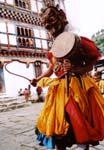 The festivals are very colourful. Each region has its own festival at different dates, based on the bhutanese calendar. The festivals that I saw are the tsechus in Bumthang. Tsechu means "10th day" and celebrations are held then because Guru Rimpoche performed all of his magical miracles on the 10th of the month. Each tsechu is dedicated to Guru Rimpoche, the Second Buddha, and includes dance dramas that illustrate his life.
The festivals are very colourful. Each region has its own festival at different dates, based on the bhutanese calendar. The festivals that I saw are the tsechus in Bumthang. Tsechu means "10th day" and celebrations are held then because Guru Rimpoche performed all of his magical miracles on the 10th of the month. Each tsechu is dedicated to Guru Rimpoche, the Second Buddha, and includes dance dramas that illustrate his life.
The Jambay Lhakhang festival starts in the evening around 6 or 7 PM, and goes on the two following days. It is well known for its walk across the fire and the naked dance. The walk across the fire takes place in the middle of the first evening, between the dances, on a big grass field. A wooden frame of 3 m (9 feet) high and 5 m (16 feet) wide is erected as a gateway. It is covered with cypress leaves that are then put on fire. Once the entire frame is burning, people run through it. I joined in the crowd and walked through the fire. Some got scared just before crossing the gateway and slowed down. But since the crowd is immense and kept coming through from behind, there was no possible stopping. With no other option, the people who slowed down had to run through the fire. A big number of Bhutanese came to the festival for this event. It is said that once you pass through the fire, you will stay healthy for one year. I hope it will be true for me.
The other attraction of this festival is the naked dance. I was told that Jambay Lhakhang is the only festival offering the naked dance. The dance takes place last, in the interior courtyard of the monastery, at the end of the night around 1 AM. People shove each other in order to get in the courtyard to watch. The dancers, monks I was told, are all naked and dance around a big fire (fortunately, since it was very cold at night as we were at 2700 m, 8860 feet in altitude). Because this is a sacred dance, no picture was allowed.
The Parkhar festival is smaller than the one at Jambay Lhakhang and only goes on for two days. However, the atmosphere there is much more convivial and intimate as it is less crowded and one can get very close to the dancers. The dance performances also seem to be of better quality. I was told that all the dancers there are "professional" monks.
Each festival has some kind of fair with food and game stands. The locals come there for the food, the drinks and to play games. Bhutanese seems to be very fond of gambling games such as the dice and the tambola, which is very similar to bingo. They play with great passion, which is a spectacle in itself.
Monuments
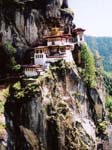 All of the monuments in Bhutan are religious or linked to Buddhism. The most remarkable ones are the dzongs and the monasteries. For certain buildings in the monasteries, and for the temples and chortens, usually one has to walk clockwise three or more times around them before entering inside; it is a way to show respect.
All of the monuments in Bhutan are religious or linked to Buddhism. The most remarkable ones are the dzongs and the monasteries. For certain buildings in the monasteries, and for the temples and chortens, usually one has to walk clockwise three or more times around them before entering inside; it is a way to show respect.
The Kingdom of Bhutan is divided into 18 districts. Each district has its own dzong, some kind of monastery fortress. Each dzong has more or less the same structure: a civic administrative part and a clerical part. The central building of the dzong is generally a monastery. Nowadays, the only people living in the dzongs are the monks. In my opinion, two dzongs stand out: the ones from Trongsa and from Punakha.
Trongsa (pronounced tong-sa) is strategically located in central Bhutan, and is historically the place from where attempts at unifying the country were launched. Its dzong thus represents Bhutan's link with its historical monarchy. It is also the investiture site for future kings ascending the Golden Throne of Bhutan. High on the slopes at 2200 m (7200 feet), the dzong is massive and impressive. It was built in 1648 on many levels into the side of the hill, and includes countless courtyards, passageways and corridors.
The most beautiful dzong in the kingdom is in my opinion the one in Punakha, which is located at the confluence of Mo Chu and Pho Chu (literally Mother and Father rivers). Its construction, foretold by Guru Rimpoche, started in 1637 and was completed one year later. The Punakha dzong was the second of the country and was the seat of the government when Punakha was the capital of Bhutan (until 1961). Not as imposing as the one in Trongsa, it is, however, more aesthetic, especially after a recent renovation. There, one can find beautiful walls painted with religious stories, columns ornamented with superb sculptures and the buildings and windows are painted with great details.
Taktsang is the most famous monastery in Bhutan, and probably the most photographed monument in the country. It is perched on a cliff 900 m (2950 feet) above the Paro valley, 3100 m (10,200 feet) in altitude. It is said that Guru Rimpoche flew to the site on the back of a tigress in the 8th century, thus the name Taktsang which means tiger's nest. He meditated there for three months in a cave where the monastery was later built. The Taktsang monastery has been one of the most sacred sites in the kingdom ever since.
Another sacred place is the Kurjey Lhakhang monastery in Bumthang. It is named after the body print that Guru Rimpoche left in the rock there during a meditation. There is also a natural cave in the rock wall of the oldest building of the monastery. The cave is a short narrow tunnel, whose entrance and exit are about 2 m (6 feet) apart. It is said that only people with no sin can enter and exit without getting stuck inside; apparently I have been good lately as I passed the test.
There are a lot of monasteries and temples to visit, and I have visited a lot of them. But it can quickly become boring if no one explains the historical values or the stories behind these places as they resemble one another and sometimes are quite ordinary. To be also noted is the National Museum in Paro that hosts a formidable collection of Bhutanese stamps (among others), even for me who is not an amateur of stamps.
Signs of Changes
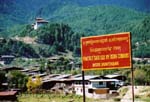 Though Bhutan still looks like a medieval country in some aspects, there are signs that changes are to come. Even though the traditional dress is still obligatory in governmental offices, at school and formal occasions, other dresses are allowed in the streets since 3 or 4 years. Now one can see a good number of young people wearing occidental clothes, especially in Thimpu. The reasons are quite practical: the gho does not keep their lower body warm enough in the winter as the cold air can come up from underneath. But in my opinion, they do not pick the best occidental fashion; they seem to have a taste for the military type of clothes or the gangsta style with baggy pants and bandana on the head.
Though Bhutan still looks like a medieval country in some aspects, there are signs that changes are to come. Even though the traditional dress is still obligatory in governmental offices, at school and formal occasions, other dresses are allowed in the streets since 3 or 4 years. Now one can see a good number of young people wearing occidental clothes, especially in Thimpu. The reasons are quite practical: the gho does not keep their lower body warm enough in the winter as the cold air can come up from underneath. But in my opinion, they do not pick the best occidental fashion; they seem to have a taste for the military type of clothes or the gangsta style with baggy pants and bandana on the head.
Although the number of tourists visiting Bhutan is still very small compared to other countries [1], such as neighbouring India, there are nevertheless quite a few, at least much more than what I expected. My guide told me that there is no longer any quota. The limitation now is based on accommodation: the number of tourists at any time is limited by the number of beds available in the hotels of the kingdom. In fact, a lot of new hotels are popping up everywhere, sometimes they are so new that they are barely finished or are still under construction! In Jakar, because a lot of people came to Bumthang for the festivals, the hotels were full and I was put in one that had just been completed. It was so new that it was not ready to accommodate people. The electrical wires were so thin that they would break when the heaters were turned on. The water pipes were still exposed and were broken when a car went over. So there was no water the first day, and there were no hot water and no heat until the third night (it was about 5º C, 40F at night and 10º, 50F in the day). In Wangdue, I was put in a hotel that were still under construction during the day. The work would stop at 4 PM so that guests can rest.
An expressway of two lanes on each side has been built in Thimpu, though not yet completely in service. It is the first one in Bhutan. Bhutanese have had television since 1999 and a lot of them have satellite dishes nowadays. Mobile phones have been in service since 2004, and travel agencies are popping up at a very fast rate. Bhutan has to modernize, that is understandable; changes are therefore unavoidable. I hope only that they will not let themselves be too influenced by occidental culture, and that they will be able to keep their culture and traditions. But above all I hope that we, the tourists, shall always respect their way of being and shall never introduce mendicancy due to our superiority complex by giving money to Bhutanese kids. The Kingdom of Bhutan is probably one of the last places of its kind, an endangered species.
Practical Details
Visiting Bhutan
 Unless one is invited by the Bhutanese or has a passport from India, no visitor can enter Bhutan without booking a tour from one of the registered tour operators in Bhutan or from their counterparts abroad. The tour operator in Bhutan will apply for the visa. The visa costs US $20, to be paid at the Paro airport, and will be stamped on the passport by an officer of the immigration.
Unless one is invited by the Bhutanese or has a passport from India, no visitor can enter Bhutan without booking a tour from one of the registered tour operators in Bhutan or from their counterparts abroad. The tour operator in Bhutan will apply for the visa. The visa costs US $20, to be paid at the Paro airport, and will be stamped on the passport by an officer of the immigration.
The minimum daily tariff is set by the Tourism Authority of Bhutan in US $200 per day and can not be negotiated. The rate is the same for both cultural tours and treks. There is a surcharge for individuals (US $40 per day) and groups of less than three persons (US $30 per day). At this price, visitors are entitled to a guide, means of transportation (cars or yaks for trekking), lodging, foods and entrance fees for the monuments.
It is highly advised that tours be booked more than three months in advance, especially during the high seasons (spring and autumn). For this trip, I arranged my tour with Jachung Travel in the San Francisco bay in the United States, which is operated by Eagles Tour in Bhutan. I traveled solo, but for some reasons, the surcharges were waved for the dates of my trip (10-24 October), and only for those dates.
Leaving Bhutan
There is some confusion at the airport as to the process to follow when leaving Bhutan since no one is given a clear explanation. Below is the process to follow.
Once you get pass the first papers check and entered the terminal, go directly to the bank counter at the end of the building to pay the departure taxes of US $12. Then come back for the security check. After passing the security check and checking in your luggage, go to the custom to get your paper stamped, even when you do not have anything to declare, before passing a second security check. Finally, go identify your luggage outside the terminal before the embarkation. You can always embark without identifying your luggage, however the airplane will not take off until all baggages are identified by their owner. My flight was delayed 30 minutes because 3 or 4 people did not know that they had to identify their luggage.
Other Details
Bhutanese currency is the ngultrum (Nu), which is equivalent to the Indian rupee. The latter is also accepted everywhere in Bhutan. It is easy to exchange the currency in the cities in Bhutan, but you have to provide your passport. Some stores, mostly in Thimpu, accept Visa. But there is an additional charge of 7% to use the card at stores that are not run by the government. There is no ATM in Bhutan.
Dates of my journey in Bhutan: 10-24 October 2005.
| City | Paro | Thimpu | Wangdue | Punakha | Trongsa | Jakar |
| Altitude | 2200 m 7200 feet |
2300 m 7540 feet | 1300 m 4260 feet |
1300 m 4260 feet | 2300 m 7450 feet |
2700 m 8860 feet |
| Temperature* | 7.4 / 18.7C 45.3 / 64.8F |
10.4 / 21.9C 50.7 / 71.4F | 14.7 / 26.1C 58.4 / 79.0F |
18.9 / 27.8C 60.0 / 82.0F | 11.7 / 21.8C 53.0 / 71.2F |
5.9 / 19.5C 42.6 / 67.1F |
[1] After further researches, I found that there were less than 9,000 tourists visiting Bhutan in 2004, a 47.6% increase from 2003. Over the same period, India had 3,368,000 visitors, or 9,227 visitors per day. Of all Asia, Hong Kong had one of the highest tourist arrivals in 2004 with 21,810,630 visitors, or 59,755 visitors daily.
Copyright © 2005, Northwest Summit. All rights reserved.
No part of this page may be reproduced, republished or copied without the express written permission of its author.